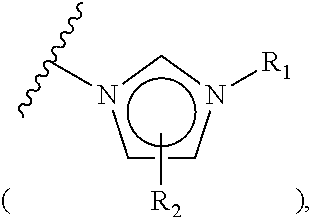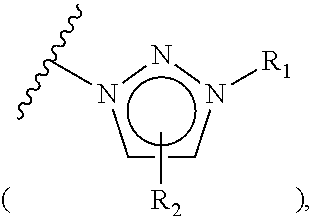Method for synthesizing radiopharmaceuticals using a cartridge
a radiopharmaceutical and cartridge technology, applied in the direction of isotope introduction to sugar derivatives, isotope introduction to acyclic/carbocyclic compounds, drug compositions, etc., can solve the problems of complex synthesis process and low synthesis yield, and achieve the effect of ensuring the performance of all reaction steps, accelerating the synthesizing of radiopharmaceuticals, and advancing the present invention
- Summary
- Abstract
- Description
- Claims
- Application Information
AI Technical Summary
Benefits of technology
Problems solved by technology
Method used
Image
Examples
example 1-1
Preparation of triethyl ammonium salt-coupled polymer (Compound 1-1a)
[0076]Chloromethyl polystyrene (1.8 mmol / g, 10.0 g, 18.0 mmol) was placed in a reactor to which a mixture of dimethylformamide (DMF) / water (90 mL / 10 mL) was then added. Subsequently, triethylamine (7.527 mL, 54.0 mmol) was introduced into the reactor. The resulting reaction mixture was well stirred at 50° C. for 3 hrs, and filtered through a Buchner funnel. The polymer filtrate was washed many times with acetone and dried in a vacuum. To the dried polymer was added an aqueous 0.2 M NaHCO3 solution (50 mL) and the solution was stirred slowly for 5 min, followed by removing the solvent in a vacuum. This procedure was repeated three times more, for a total of 4 times. The polymer was washed once with distilled water and many times with acetone, and evaporated in a vacuum to the point of dryness to afford triethylammonium salt-coupled polymer 1-1a (12.15 g, 1.48 mmol / g). The synthesis procedure is illustrated in Reacti...
example 1-2
Preparation of N-methylimidazolium salt-coupled polymer (Compound 1-1b)
[0078]Chloromethyl polystyrene (1.8 mmol / g, 10.0 g, 18.0 mmol) was placed in a reactor to which a mixture of dimethylformamide / water (90 mL / 10 mL) was then added. Subsequently, N-methylimidazole (4.304 mL, 54.0 mmol) was introduced into the reactor. The resulting reaction mixture was well stirred at 50° C. for 3 hrs, and filtered through a Buchner funnel. The polymer filtrate was washed many times with acetone and dried in a vacuum. To the dried polymer was added an aqueous 0.2 M NaHCO3 solution (50 mL) and the solution was stirred slowly for 5 min, followed by removing the solvent in a vacuum. This procedure was repeated three times more. The polymer was washed once with distilled water and many times with acetone, and evaporated in a vacuum to the point of dryness to afford N-imidazolium salt-coupled polymer 1-1b (11.82 g, 1.52 mmol / g). The synthesis procedure is illustrated in Reaction Scheme 1-2.
[0079]On an I...
example 1-3
Preparation of triethylammonium salt-coupled polymer (Compound 1-1c)
[0080]n-Hexyl methanesulfonate polystyrene (1.67 mmol / g, 10.0 g, 16.7 mmol) was placed in a reactor to which a mixture of acetonitrile / water (50 mL / 5 mL) was then added. Subsequently, N-methylimidazole (6.65 mL, 83.5 mmol) was introduced into the reactor. The resulting reaction mixture was well stirred at 60° C. for 3 hrs, and filtered through a Buchner funnel. The polymer filtrate was washed many times with acetone and dried in a vacuum. To the dried polymer was added an aqueous 0.2 M NaHCO3 solution (50 mL) and the solution was stirred slowly for 5 min, followed by removing the solvent in a vacuum. This procedure was repeated three times more. The polymer was washed once with distilled water and many times with acetone, and evaporated in a vacuum to dryness to afford triethylammonium salt-coupled polymer 1-1c (11.72 g, 1.42 mmol / g). The synthesis procedure is illustrated in Reaction Scheme 1-3.
[0081]On an IR spect...
PUM
| Property | Measurement | Unit |
|---|---|---|
| Acidity | aaaaa | aaaaa |
Abstract
Description
Claims
Application Information
 Login to View More
Login to View More - R&D
- Intellectual Property
- Life Sciences
- Materials
- Tech Scout
- Unparalleled Data Quality
- Higher Quality Content
- 60% Fewer Hallucinations
Browse by: Latest US Patents, China's latest patents, Technical Efficacy Thesaurus, Application Domain, Technology Topic, Popular Technical Reports.
© 2025 PatSnap. All rights reserved.Legal|Privacy policy|Modern Slavery Act Transparency Statement|Sitemap|About US| Contact US: help@patsnap.com



